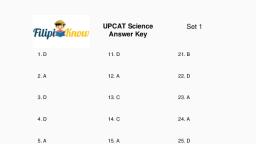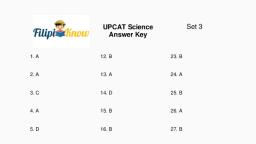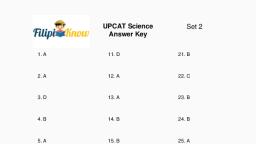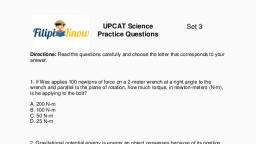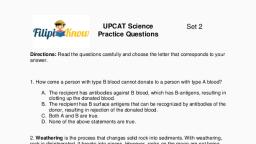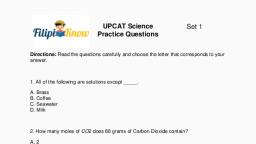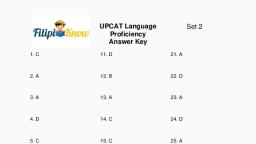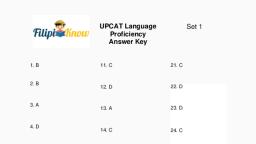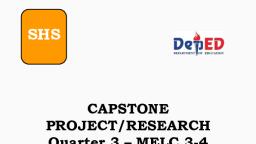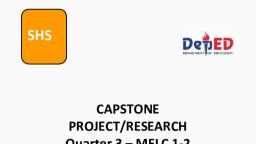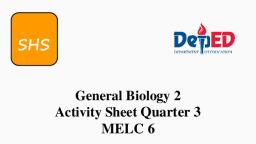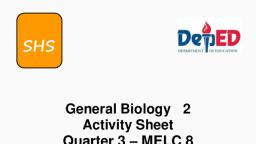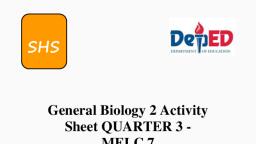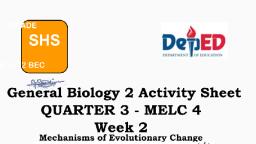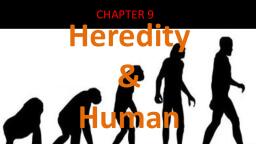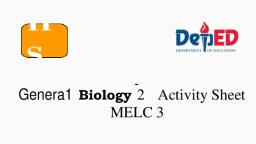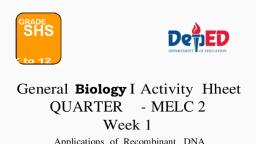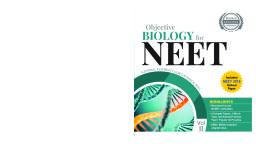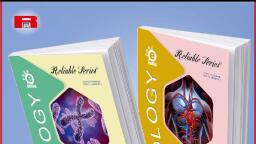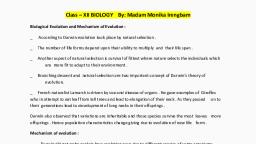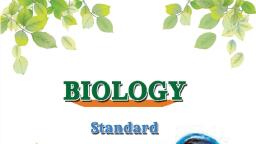Page 1 :
SHS, , General Biology 2 Activity, Sheet Quarter 3 – MELC 5, , Week 3, Patterns of Descent, , REGION VI-WESTERN VISAYAS
Page 2 :
General Biology 2, Activity Sheet No. 5 - Patterns of Descent, First Edition, 2021, Published in the Philippines, By the Department of Education, Region 6 – Western Visayas, Republic Act 8293, section 176 states that: No copyright shall subsist in any work, of the Government of the Philippines. However, prior approval of the government agency or, office wherein the work is created shall be necessary for exploitation of such work for profit., Such agency or office may, among other things, impose as a condition the payment of, royalties., This Learning Activity Sheet is developed by DepEd Region 6 – Western Visayas., ALL RIGHTS RESERVED. No part of this learning resource may be reproduced or, transmitted in any form or by any means electronic or mechanical without written permission, from the DepEd Regional Office 6 – Western Visayas., , Development Team of Activity Sheet, Writer: JALE ANN PEARL D. YECLA, Content and Language Editing:, MARY CHERRY LYNN M. DALIPE, Division of Aklan Management Team:, Miguel Mac D. Aposin, Samuel J. Malayo, Dobie P. Parohinog, Mary Cherry Lynn M. Dalipe, Mahnnie Q. Tolentino, Regional Management Team, , Ramir B. Uytico, Pedro T. Escobarte, Jr., Elena P. Gonzaga, Donald T. Genine, Rovel R. Salcedo, Moonyeen C. Rivera, Anita S. Gubalane, Minda L. Soldevilla, Daisy L. Lopez, Joseph M. Pagalaran
Page 3 :
Introductory Message, Welcome to Biology 2!, The Learning Activity Sheet is a product of the collaborative efforts of the, Schools Division of Guimaras and DepEd Regional Office VI - Western, Visayas through the Curriculum and Learning Management Division (CLMD)., This is developed to guide the learning facilitators (teachers, parents and, responsible adults) in helping the learners meet the standards set by the K to, 12 Basic Education Curriculum., The Learning Activity Sheet is self-directed instructional materials, aimed to guide the learners in accomplishing activities at their own pace and, time using the contextualized resources in the community. This will also, assist the learners in acquiring the lifelong learning skills, knowledge and, attitudes for productivity and employment., , For learning facilitator:, The General Biology 2 Activity Sheet will help you facilitate the teachinglearning activities specified in each Most Essential Learning Competency (MELC), with minimal or no face-to-face encounter between you and learner. This will be, made available to the learners with the references/links to ease the independent, learning., , For the learner:, The General Biology 2 Activity Sheet is developed to help you continue, learning even if you are not in school. This learning material provides you with, meaningful and engaging activities for independent learning. Being an active learner,, carefully read and understand the instructions then perform the activities and, answer the assessments. This will be returned to your facilitator on the agreed, schedule.
Page 4 :
Name of Learner:, Grade and Section:, , Date:, , BIOLOGY 2 LEARNING ACTIVITY SHEET `NO. 5, Patterns of Descent, , I. Learning Competency with Code, Show patterns of descent with modification from common ancestors to produce the, organismal diversity observed today. (STEM_BIO11/12-IIIc-g-10), , II. Background Information for Learners, While most of you are confused about the descent of modification, this, concept was actually realized in the mid-nineteenth century through observation by, the two naturalists, Charles Darwin and Alfred Russel Wallace. Darwin is considered, to be the “Father of Natural Selection” but the actual concept was actually developed, both by Darwin and Wallace. Both of them observed similar patterns in other, organisms and they independently developed the same explanation for how and why, such changes occur. Darwin called it a natural selection, also known as the, “survival of the fittest”, it is the proliferation of individuals with favorable traits and, is evident on the survival of the species due to environmental change that can be, passed on to the next generation., Darwin himself used the phrase “descent with modification” but was, reformed to the word “evolution” through time. The discovery of the descent with, modification did not stop with their works in fact, the search for evidences continue, to strengthen the “Theory of Evolution”. The theory of evolution is based on the idea, that all species are related and gradually change over time., Genetic differences are heritable and can be passed on to the next, generation and in other way it can be altered depending on the environmental factors, creating a modified characteristic different from its ancestors. Descent with, modification suggest that each species has descended with changes from other, species over time and that all species living and extinct share a common ancestor. It, is a predictable and a long-term outcome of several principles taken from nature., The passing on of traits from parent to their offspring is called heredity and gene as its, basic unit. Gene is a blueprint that holds the information in making an organism., The passing of gene is not always exact. In a sexual reproduction for example, genes, of one parent are combined to another parent organism. This is why there are no, organisms seen to have an exact copy of genes or ambiguos features with their, parents. In other words, evolution gave the idea that nobody looks exactly like his, parents., Small changes in every generation over billions of years have led to new, species branching from one common ancestor creating a “tree of life”. These changes, occur in the DNA inside a gene. Factors leading to these changes could be due to, adaptation, natural selection or survival of the fittest, genetic drift, mutation and, recombination as discussed in your previous learning activity. In each case, the, offspring in the population will have slightly different genes than the parents. These, are the reasons for the organismal diversity., Most species came from one common ancestor that diverge or converge, through time affecting physical transition. It can undergo various kinds of natural, , 1
Page 5 :
selection and may engage in several patterns of evolution. Environmental factors can, have several effects on how species are exposed to them. This could lead to the two, main types of evolutional patterns: convergent and divergent evolution as sshown in, the figure below., , Figure 1., , (A)divergent, evolution (B)convergent evolution, , Divergent evolution occurs when closely related species diverge to, form new species from a common ancestor. This type of evolution contributed to the, current diversity of species on earth. This evolutional pattern may occur in response, to changes in environmental conditions, competition, predation, or when a new niche, is become available. Through divergent evolution, organisms may develop, homologous structures. These are anatomically similar, which are present in the, common ancestor and persist within the diverged organisms, although have evolved, dissimilar functions., , Figure 2. Darwin’sfinches in the Galapagos Islands, showing divergent evolution., , Example is the Darwin’s finches in, the Galapagos Islands, with, several, species matching with their unique beak, shape ( see Figure 2). The species on the, islands had a graded beak sizes and, shapes with very small differences, between the most similar. From it, he, concluded that the varied beaks evolved to, help the birds acquire a specific type of, food. In his search, he found out that the, variation in their finches was used for a, different type of food available in their, environment., , Convergent evolution takes place when two different species started to share the, same traits because they are in the same environment. Species can converge in, sympatry. An example of convergent evolution is the similar nature of wings of, insects, birds and bats., A butterfly species in Figure 3, is, an example of species that adapted to, change. The alteration of butterfly, wings’ color as seen in the illustration, evolve to help them protect themselves, from predators. Beyond butterflies, it, is possible that this type of speciation, has been part of the species, convergence They evolve after one has, become aposematic (warningly colored), because it is toxic or poisonous., , 2
Page 6 :
Figure 3. Modification of butterfly wings,showing a, convergent evolution., , Today, it is clearly understood that, organisms descended from ancestral species. The organisms that you see now could, be a way different before or could be from the same ancestors but have changed, through time because of the above-mentioned environmental factors., To understand it better, unfold this mechanism as you go on with this learning, activity., , III. Activity Proper, Activity 1, Theory of Descent with Modification, 1. How does the descent of modification occur? What are the environmental, factors involve?, , 2. Provided with the evidences below, choose which of these represents descent with, modification., A.), , B.), , 3. Based on your choice, explain why it is considered as a descent with, modification? Provide one theory or evidence to support your answer., , 3
Page 7 :
Activity 2, Patterns of Descent with Modification From, Common Ancestors, 1. Dog is a common pet found at home. Using this species create a diagram to show, patterns of descent with modification of dog from its common ancestor. You can, use the internet or book for your reference. Answers could be in a form of, drawing or word. Arrows can be use in indicating the modification. (Please see, example below), Example: The descent of modification or evolution of cat., , 2. What pattern of evolution this species represents? Explain your answer., , IV. Reflection, If you have a power to modify a part of yourself, what would it be? Why?, _, _, , 4
Page 8 :
5

